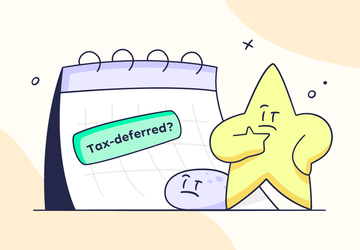7 Benefits of Tax-Deferred Accounts to Save $1,500 Annually
Consider the possibility of having an additional $1,500 in your pockets every year. It may seem unbelievable, but with tax-deferred accounts, this could be your experience.
These are powerful money instruments that offer various features aimed at allowing you to save money, reduce your tax burden, and stabilize your financial situation in the future.
Through proper management of the tax-deferred accounts, you will witness your balances rise beyond your expectations.
Today’s blog post will focus on seven powerful advantages of tax-sheltered accounts that may contribute to your savings of $1,500 per year. Here you will learn how to get the most out of your money.
Don’t wait any longer and learn the secrets that will help you to become financially successful and manage your financial life.
7 Benefits of Tax-Deferred Accounts to Save $1,500 Annually

These are some of the benefits explaining the beauty of tax-deferred plans and what a positive impact they could bring to your savings.
1. Immediate Tax Savings
One advantage of contributing to tax-sheltered accounts is the potential immediate tax advantages you can reap. By directing a part of your earnings to accounts such as traditional IRAs or 401(k)s, you are in a position to reduce the amount of taxable income.
This reduction results in the amount of taxes paid being less, thus implying a lot of savings. For example, if you invest $5,000 in a tax-deferred account and you are in the 24% tax bracket, then you’ll be able to save $1,200 when you file your taxes.
To achieve this, you need to ensure that you are making as many deposits into these accounts in a year as possible because the more money you put into these accounts, the more money you stand to save in a year.
2. Compounding Growth
The second advantage of investing in tax-deferred accounts is the compounding of wealth by way of growth. These are accounts that enable your money to be invested and earn interest without paying taxes until the time you wish to cash them, usually during your retirement.
This tax deferred growth helps your investments to grow at a faster pace than what would have been possible in the case of other types of investment accounts.
Because taxes are only paid on gains each year and not on the total value of the portfolio, more of it remains invested, which in turn can lead to higher long-term returns.
In the long run, regular investment over time can greatly amplify your retirement accounts to create a larger corpus.
3. Lower Tax Bracket in Retirement
Tax-deferred accounts present a valuable advantage: the reality of slipping to a lower tax band once one is in retirement. If you contribute to these accounts during your working-age years, it is usually when your earnings, and therefore your tax bracket, are higher.
However, upon retiring and pulling out money from these tax-favored accounts, one may be in a lower tax bracket. As a result, you might be in a lower tax bracket when withdrawing money than when you were working and earning income.
This is where planning your withdrawals and considering your retirement tax rate will help lower your overall tax bill and keep more of your money saved for retirement.
4. Flexible Contribution Limits
Tax-sheltered plans are known to have higher contribution limits compared to other saving plans to allow for flexibility in saving. For example, in 2023, the contribution limit of 401(k) is $22,500, with an additional catch-up contribution of $7,500 for individuals who are fifty years old and above.
These favorable rules allow you to save more money for taxes every year, thus allowing you to save more of your income. Making the maximum contribution lets you get the most from the tax benefits and investment growth of the accounts.
Ideally, it is impossible to contribute the maximum, but the more possible within these limits is the best one can do to save, and it will make a lot of difference in the long run.
5. Employer Contributions
If you have access to an employer-sponsored retirement plan like a 401(k), you might be eligible for a valuable perk: Contributions by the employer. Some employers contribute a portion of the funds to these plans as a form of matching.
Employer matches are simply extra money that goes into your retirement fund and is, therefore, free money.
For instance, if your employer contributes 50% of your contribution up to 6% of your salary and your salary is $ 50,000 per annum, you can receive an additional $ 1,500 from your employer if you contribute 6% of your salary or more towards pension.
It is important to maximize employer contributions as it helps you to increase your retirement benefits without having to contribute an extra dime.
6. Investment Flexibility

Tax-advantaged plans provide investors with a wide range of choices in terms of the types of investments they can make in their accounts, which means that they can tailor their investment strategies to their needs and preferences.
No matter whether you are more inclined to play it safe and stick with lower-risk options or you’re willing to take more chances and look at higher-risk opportunities, you will be able to find the right options within these accounts.
Some of the most common investment types are shares, bonds, mutual funds, and target date funds. Thus, diversification helps to control risk and simultaneously increase potential returns across a range of different types of assets and industries.
It allows you to have more control over your financial life and make necessary changes concerning your investment plans based on your evolving needs and preferences.
7. Potential for Tax-Free Withdrawals
Most of the tax-deferred accounts are such that one is required to pay taxes on the money withdrawn during the retirement stage, but some may allow one to get a tax-free income, for instance, the Roth IRA.
In a Roth IRA, you invest after-tax dollars, which means that your earnings are not taxed as long as they are in the account.
Even though you are free to withdraw your contributions at any time, there are special conditions under which you can withdraw both contributions and earnings without incurring taxes: if you have held the account for at least five years and you are over 59½ years old.
This is tax-free income, which is very beneficial when one is in retirement as it allows for more flexibility than having to pay taxes on the funds.
Furthermore, Roth IRAs do not have RMDs during the lifetime of the account owner, which makes it all the easier for you when planning for your retirement.
Start Saving with Tax-Deferred Accounts Today
Do not let the great opportunities of tax-privileged accounts pass by. With these strategies, you can pave the way for a better financial future and conserve a lot of money in the process.
It is high time that you start prioritizing your retirement savings. The key reason is that the more time one has to save and invest money, the more it will grow and compound.
Discover what many have already been able to witness in terms of the positive changes that occur when investing in tax-sheltered plans. It is time to save up to $1,500 per year and ensure better prospects financially speaking in the future.
Your future self will be grateful for this conscious choice.





